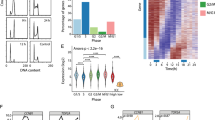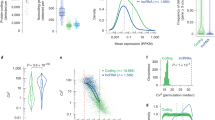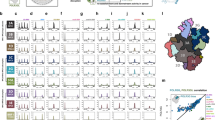Abstract
Transcription of long noncoding RNAs (lncRNAs) within gene regulatory elements can modulate gene activity in response to external stimuli, but the scope and functions of such activity are not known. Here we use an ultrahigh-density array that tiles the promoters of 56 cell-cycle genes to interrogate 108 samples representing diverse perturbations. We identify 216 transcribed regions that encode putative lncRNAs, many with RT-PCR–validated periodic expression during the cell cycle, show altered expression in human cancers and are regulated in expression by specific oncogenic stimuli, stem cell differentiation or DNA damage. DNA damage induces five lncRNAs from the CDKN1A promoter, and one such lncRNA, named PANDA, is induced in a p53-dependent manner. PANDA interacts with the transcription factor NF-YA to limit expression of pro-apoptotic genes; PANDA depletion markedly sensitized human fibroblasts to apoptosis by doxorubicin. These findings suggest potentially widespread roles for promoter lncRNAs in cell-growth control.
This is a preview of subscription content, access via your institution
Access options
Subscribe to this journal
Receive 12 print issues and online access
$209.00 per year
only $17.42 per issue
Buy this article
- Purchase on Springer Link
- Instant access to full article PDF
Prices may be subject to local taxes which are calculated during checkout








Similar content being viewed by others
Accession codes
References
Bertone, P. et al. Global identification of human transcribed sequences with genome tiling arrays. Science 306, 2242–2246 (2004).
Carninci, P. et al. The transcriptional landscape of the mammalian genome. Science 309, 1559–1563 (2005).
Calin, G.A. et al. Ultraconserved regions encoding ncRNAs are altered in human leukemias and carcinomas. Cancer Cell 12, 215–229 (2007).
Carninci, P. Non-coding RNA transcription: turning on neighbours. Nat. Cell Biol. 10, 1023–1024 (2008).
Mattick, J.S. & Makunin, I.V. Small regulatory RNAs in mammals. Hum. Mol. Genet. 14 Spec No 1, R121–R132 (2005).
He, L. & Hannon, G.J. MicroRNAs: small RNAs with a big role in gene regulation. Nat. Rev. Genet. 5, 522–531 (2004).
Hutvagner, G. & Simard, M.J. Argonaute proteins: key players in RNA silencing. Nat. Rev. Mol. Cell Biol. 9, 22–32 (2008).
Kapranov, P. et al. RNA maps reveal new RNA classes and a possible function for pervasive transcription. Science 316, 1484–1488 (2007).
Seila, A.C. et al. Divergent transcription from active promoters. Science 322, 1849–1851 (2008).
Taft, R.J. et al. Tiny RNAs associated with transcription start sites in animals. Nat. Genet. 41, 572–578 (2009).
Core, L.J., Waterfall, J.J. & Lis, J.T. Nascent RNA sequencing reveals widespread pausing and divergent initiation at human promoters. Science 322, 1845–1848 (2008).
Ponjavic, J., Ponting, C.P. & Lunter, G. Functionality or transcriptional noise? Evidence for selection within long noncoding RNAs. Genome Res. 17, 556–565 (2007).
Struhl, K. Transcriptional noise and the fidelity of initiation by RNA polymerase II. Nat. Struct. Mol. Biol. 14, 103–105 (2007).
Guttman, M. et al. Chromatin signature reveals over a thousand highly conserved large non-coding RNAs in mammals. Nature 458, 223–227 (2009).
Katayama, S. et al. Antisense transcription in the mammalian transcriptome. Science 309, 1564–1566 (2005).
Kim, T.K. et al. Widespread transcription at neuronal activity-regulated enhancers. Nature 465, 182–187 (2010).
De Santa, F. et al. A large fraction of extragenic RNA pol II transcription sites overlap enhancers. PLoS Biol. 8, e1000384 (2010).
Wang, X. et al. Induced ncRNAs allosterically modify RNA-binding proteins in cis to inhibit transcription. Nature 454, 126–130 (2008).
Pasmant, E. et al. Characterization of a germ-line deletion, including the entire INK4/ARF locus, in a melanoma-neural system tumor family: identification of ANRIL, an antisense noncoding RNA whose expression coclusters with ARF. Cancer Res. 67, 3963–3969 (2007).
Yu, W. et al. Epigenetic silencing of tumour suppressor gene p15 by its antisense RNA. Nature 451, 202–206 (2008).
Lee, J.T. Lessons from X-chromosome inactivation: long ncRNA as guides and tethers to the epigenome. Genes Dev. 23, 1831–1842 (2009).
Rinn, J.L. et al. Functional demarcation of active and silent chromatin domains in human HOX loci by noncoding RNAs. Cell 129, 1311–1323 (2007).
Gupta, R.A. et al. Long non-coding RNA HOTAIR reprograms chromatin state to promote cancer metastasis. Nature 464, 1071–1076 (2010).
Huarte, M. et al. A large intergenic noncoding RNA induced by p53 mediates global gene repression in the p53 response. Cell 142, 409–419 (2010).
Sherr, C.J. & Roberts, J.M. CDK inhibitors: positive and negative regulators of G1-phase progression. Genes Dev. 13, 1501–1512 (1999).
Hall, M. & Peters, G. Genetic alterations of cyclins, cyclin-dependent kinases, and Cdk inhibitors in human cancer. Adv. Cancer Res. 68, 67–108 (1996).
Johnson, D.G. & Walker, C.L. Cyclins and cell cycle checkpoints. Annu. Rev. Pharmacol. Toxicol. 39, 295–312 (1999).
Rando, O.J. & Chang, H.Y. Genome-wide views of chromatin structure. Annu. Rev. Biochem. 78, 245–271 (2009).
Bock, C., Halachev, K., Buch, J. & Lengauer, T. EpiGRAPH: user-friendly software for statistical analysis and prediction of (epi)genomic data. Genome Biol. 10, R14 (2009).
Lin, M., Jungreis, I. & Kellis, M. PhyloCSF: a comparative genomics method to distinguish protein-coding and non-coding regions. Nature Precedings published online, doi:10.1038/npre.2010.4784.1 (18 August 2010).
Wong, D.J. et al. Module map of stem cell genes guides creation of epithelial cancer stem cells. Cell Stem Cell 2, 333–344 (2008).
Segal, E., Friedman, N., Koller, D. & Regev, A. A module map showing conditional activity of expression modules in cancer. Nat. Genet. 36, 1090–1098 (2004).
Subramanian, A. et al. Gene set enrichment analysis: a knowledge-based approach for interpreting genome-wide expression profiles. Proc. Natl. Acad. Sci. USA 102, 15545–15550 (2005).
Whitfield, M.L. et al. Identification of genes periodically expressed in the human cell cycle and their expression in tumors. Mol. Biol. Cell 13, 1977–2000 (2002).
Wei, C.L. et al. A global map of p53 transcription-factor binding sites in the human genome. Cell 124, 207–219 (2006).
Geisler, S. et al. Influence of TP53 gene alterations and c-erbB-2 expression on the response to treatment with doxorubicin in locally advanced breast cancer. Cancer Res. 61, 2505–2512 (2001).
Olive, K.P. et al. Mutant p53 gain of function in two mouse models of Li-Fraumeni syndrome. Cell 119, 847–860 (2004).
Agarwal, M.L., Agarwal, A., Taylor, W.R. & Stark, G.R. p53 controls both the G2/M and the G1 cell cycle checkpoints and mediates reversible growth arrest in human fibroblasts. Proc. Natl. Acad. Sci. USA 92, 8493–8497 (1995).
Di Leonardo, A., Linke, S.P., Clarkin, K. & Wahl, G.M. DNA damage triggers a prolonged p53-dependent G1 arrest and long-term induction of Cip1 in normal human fibroblasts. Genes Dev. 8, 2540–2551 (1994).
Morachis, J.M., Murawsky, C.M. & Emerson, B.M. Regulation of the p53 transcriptional response by structurally diverse core promoters. Genes Dev. 24, 135–147 (2010).
Michlewski, G. & Caceres, J.F. RNase-assisted RNA chromatography. RNA 16, 1673–1678 (2010).
Khalil, A.M. et al. Many human large intergenic noncoding RNAs associate with chromatin-modifying complexes and affect gene expression. Proc. Natl. Acad. Sci. USA 106, 11667–11672 (2009).
Tsai, M.C. et al. Long noncoding RNA as modular scaffold of histone modification complexes. Science 329, 689–693 (2010).
Kanhere, A. et al. Short RNAs are transcribed from repressed polycomb target genes and interact with polycomb repressive complex-2. Mol. Cell 38, 675–688 (2010).
Han, J., Kim, D. & Morris, K.V. Promoter-associated RNA is required for RNA-directed transcriptional gene silencing in human cells. Proc. Natl. Acad. Sci. USA 104, 12422–12427 (2007).
Schwartz, J.C. et al. Antisense transcripts are targets for activating small RNAs. Nat. Struct. Mol. Biol. 15, 842–848 (2008).
Mattick, J.S. Challenging the dogma: the hidden layer of non-protein-coding RNAs in complex organisms. Bioessays 25, 930–939 (2003).
Taylor, J., Schenck, I., Blankenberg, D. & Nekrutenko, A. Using galaxy to perform large-scale interactive data analyses. Curr. Protoc. Bioinformatics Chapter 10, Unit 10.5 (2007).
Lin, M.F. et al. Revisiting the protein-coding gene catalog of Drosophila melanogaster using 12 fly genomes. Genome Res. 17, 1823–1836 (2007).
Lin, M.F., Deoras, A.N., Rasmussen, M.D. & Kellis, M. Performance and scalability of discriminative metrics for comparative gene identification in 12 Drosophila genomes. PLOS Comput. Biol. 4, e1000067 (2008).
Kosiol, C., Holmes, I. & Goldman, N. An empirical codon model for protein sequence evolution. Mol. Biol. Evol. 24, 1464–1479 (2007).
van de Vijver, M.J. et al. A gene-expression signature as a predictor of survival in breast cancer. N. Engl. J. Med. 347, 1999–2009 (2002).
Rinn, J.L., Bondre, C., Gladstone, H.B., Brown, P.O. & Chang, H.Y. Anatomic demarcation by positional variation in fibroblast gene expression programs. PLoS Genet. 2, e119 (2006).
Acknowledgements
We thank J. Rinn, M. Guttman and A. Regev for discussions, L. Attardi for careful reading of the manuscript and P. Khavari for reagents. Y.W., B.K. and Yu Wang are employees of Life Technologies. This work was supported by grants from the US National Institutes of Health (NIH)/National Institute of Arthritis and Musculoskeletal and Skin Diseases (NIAMS) (K08-AR054615 to D.J.W.), NIH/National Cancer Institute (NCI) (R01-CA118750 to H.Y.C.and R01-CA130795 to M.L.W.), the Juvenile Diabetes Research Foundation (S.K.K. and H.Y.C.) and the American Cancer Society (H.Y.C.). H.Y.C. is an Early Career Scientist of the Howard Hughes Medical Institute. T.H. is supported by the Stanford Graduate Fellowship, the National Science Foundation (NSF) Graduate Research Fellowship and the Department of Defense (DoD) National Defense Science & Engineering Graduate Fellowship (NDSEG).
Author information
Authors and Affiliations
Contributions
H.Y.C. and D.J.W. initiated the project. H.Y.C., D.J.W. and T.H. designed the experiments. T.H. performed the experiments and the computational analysis. Yulei Wang, Yu Wang and B.K. conducted high-throughput TaqMan RT-PCRs. M.F.L. and M.K. contributed CSF analysis. The following authors contributed samples or reagents: A.K.K., Y.K., G.D.G., H.M.H., N.S., C.U., P.W., A.L., S.K.K., M.v.d.V., A.-L.B.-D., S.S., M.L.W. and Y.X. The manuscript was prepared by H.Y.C., T.H. and D.J.W. with input from all co-authors.
Corresponding authors
Ethics declarations
Competing interests
The authors declare no competing financial interests.
Supplementary information
Supplementary Text and Figures
Supplementary Figures 1–11 and Supplementary Tables 1, 2 and 5. (PDF 1466 kb)
Supplementary Table 3
List of cell cycle promoter transcripts (XLSX 25 kb)
Supplementary Table 4
Combined expression of all transcripts across all tiling arrays (XLSX 107 kb)
Rights and permissions
About this article
Cite this article
Hung, T., Wang, Y., Lin, M. et al. Extensive and coordinated transcription of noncoding RNAs within cell-cycle promoters. Nat Genet 43, 621–629 (2011). https://doi.org/10.1038/ng.848
Received:
Accepted:
Published:
Issue Date:
DOI: https://doi.org/10.1038/ng.848
This article is cited by
-
The m6A methyltransferase METTL3 drives thyroid cancer progression and lymph node metastasis by targeting LINC00894
Cancer Cell International (2024)
-
Genome-wide analysis and functional annotation of chromatin-enriched noncoding RNAs in rice during somatic cell regeneration
Genome Biology (2022)
-
IDDLncLoc: Subcellular Localization of LncRNAs Based on a Framework for Imbalanced Data Distributions
Interdisciplinary Sciences: Computational Life Sciences (2022)
-
The Role of Extracellular Non-coding RNAs in Atherosclerosis
Journal of Cardiovascular Translational Research (2022)
-
Lnc-DC promotes estrogen independent growth and tamoxifen resistance in breast cancer
Cell Death & Disease (2021)



